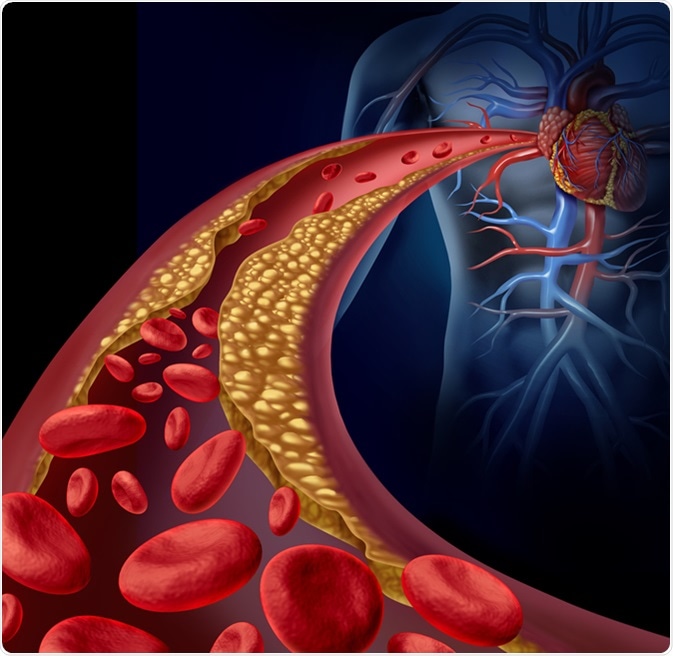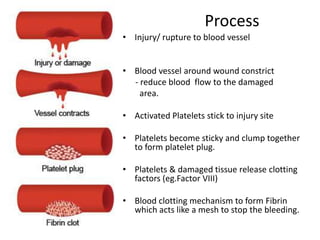Describe the Process of Blood Clotting.
Formation of factor X and prothrombinase. The blood clotting process are vasoconstriction platelet activation thrombus formation and dissolution of the clot.
What is involved in blood clotting process.

. Its vital that blood clots when we have a surface injury that breaks blood vessels. The Blood clotting mechanism has various steps that finally result in Blood Coagulation. This gel-like mass is created from fibrin and platelets.
Blood Coagulation is the process of forming a clot or thrombus in order to prevent excess loss of blood from the body. Blood clotting or coagulation is an important process that prevents excessive bleeding when a blood vessel is injured. Thrombyocytes participate in clot formation fibrinogrn converted into.
It is a gel-like mass which is formed by the platelets and fibrin in the blood. The plasma protein fibrinogen is converted into a non-globular and insoluble protein called fibrin. Blood clotting normally occurs when there is damage to a blood vessel.
1 Intrinsic and extrinsic pathways are 2 separate pathways that lead to the formation of a clot. Tap again to see term. Next small molecules called clotting factors cause strands of blood-borne materials called fibrin to stick together.
Blood cells involved are platelets ie. A platelet plug is formed and the external bleeding stops. The human body protects against loss of blood through the clotting mechanism.
Reddish brown scum formed at the site of a cut is due to clot formed mainly of a network of threads called fibrins in which dead and damaged formed elements of blood are trapped. Blood coagulation or clotting is the mechanism to prevent excessive loss of blood from the body. Platelets immediately begin to adhere to the cut edges of the vessel and release chemicals to attract even more platelets.
Blood clotting technically blood coagulation is the process by which liquid blood is transformed into a solid state. Clots also form inside our body when a blood vessel is injured. This is known as the coagulation cascade.
Vascular mechanisms platelets coagulation factors. Injury to blood vessels Injury to a blood vessel results to exposure of materials that are not normally in. The Blood Coagulation definition states that the Blood clotting mechanism is the process through which a thrombus or clot is formed which restricts excess Blood from flowing out.
Coagulation is the process of forming a blood clot. Blood clotting is initiated in one of two ways. Click again to see term.
E rst referred to as the intrinsic or internal pathway occurs when a clot forms inside. The three stages of blood clotting are the vascular phase the platelet phase and the coagulation phase. Blood is generated via hematopoiesis and ultimately becomes the delivery method for oxygen to the tissues and cells.
Thus the serum is blood minus the clot. Platelet adhesion Platelets play a key role in blood clotting. Blood clotting or coagulation is a biological process that stops bleeding.
This blood clotting is a complex process involving many clotting factors incl. The process takes place in order to prevent the body from losing too much blood due to injury. Heres how the process works.
Blood is a necessary component of the human body and the loss of this fluid may be life-threatening. The entire process of blood clotting may be referred to as hemostasis. Learn vocabulary terms and more with flashcards games and other study tools.
When the human body is injured a natural healing process is initiated in order to avoid blood. The mechanism which helps the body in order to prevent from constant loss of blood is known as hemostasis. A cut on the skin or an internal injury creates a small tear in a blood vessel wall which causes blood flow.
It begins with trauma to the lining of the blood vessel. The blood clotting process or coagulation is an important process that prevents excessive building in case the blood vessel becomes injured. Conversion of prothrombin into t.
1Release of thromboplastin and prothrombinase enzyme- AAs soon as you get wounded your affected tissues will start. Tap card to see definition. Process of Blood Coagulation.
When your body detects a bleed the clotting factors are switched on in a particular order one after the other. Tap card to see definition. Injured vessel walls and platelets release clotting factors.
In the intrinsic pathway the collagen of the damaged blood vessel initiates a string of reactions that activates factor X. The coagulation process can be described in three major steps. The intrinsic pathway is activated early in the coagulation cascade known.
After the formation of clot the clot retracts and a straw colored fluid called serum is separated. Prothrombinase can form either inside the blood vessels intrinsically or outside the blood vessels extrinsically. Fibrin is created in threads which results.
Typically your body will naturally dissolve the blood clot after the injury has healed. Red blood cells also get stuck in the fibrin mesh forming a clot. Protein involved in the blood clotting process are iron blood cells haemaglobin iron.
- i Formation of thromboplastin ii Formation of thrombin from prothrombin iii Formation of fibrin from fibrinogen. Click card to see definition. This cascade culminates into the formation of a plug that closes up the damaged site of the blood vessel controlling the bleeding.
Each factor activates the next until they form a clot. How does a blood clotting mechanism work. To control blood loss the blood vessel immediately narrows called constriction which limits.
The blood clotting process includes three main following phases. Start studying Blood Clotting Process. 10-Step Process of Blood Coagulation Step 1.
Stick together to form clumps that get stuck in the fibrin mesh. Platelets a type of blood cell and proteins in your plasma the liquid part of blood work together to stop the bleeding by forming a clot over the injury. Clotting can prevent us from bleeding to death and protect us from the entry of bacteria and viruses.
Click card to see definition. Fibrins are formed by the conversion of inactive fibrinogens in the plasma by the enzyme thrombin. It is a process that involves multiple interlinked steps.
Basic laboratory tests used to identify blood clotting problems will also be presented. This develops into a scab which protects the wound as it heals. Calcium ions enzymes platelets damaged tissues activating each other.

How Blood Clots Blood Disorders Msd Manual Consumer Version
What Are The Simple Steps Of Blood Clotting Quora

No comments for "Describe the Process of Blood Clotting."
Post a Comment